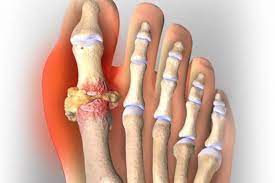Table of Contents

Gouty arthritis is a metabolic inflammatory disorder. It is a metabolic inflammatory disorder of the joints.
It is characterized by severe pain and redness of the big toe and other affected joints.
It is usually genetic, and there is a disorder in uric acid metabolism, this leads to an increase in uric acid in the blood (hyperuricemia).
The major form of uric acid implicated in gout is monosodium urate, this monosodium urate accumulates in the joints and cartilages.
In gout formation of urate crystals in the kidney can also occur, which can lead to kidney stones, painful urination, and kidney damage.
In gouty arthritis, painful attacks often begin at night and may last for a week or two.
Uric acid is a waste product majorly excreted by the kidneys, the build-up of uric in the body accumulates as needle-like crystals.
RISK FACTORS
1. Aging population.
2. Obesity
3. Heart Disorders.
4. Kidney disease or dialysis.
5. The use of high loop diuretics especially thiazides (Hydrochlorothiazide etc) by persons with cardiovascular diseases.
6. Overweight
7. Poor diet
8. Excessive alcohol consumption
9.Various physiological and external stress.
10. Gender, affects middle-aged men more than women.
Gout was first called the disease of the affluent class because it majorly affects people of the affluent class.
It was thought to be common in the cold regions of the world, but recent research shows that it is common in both the cold and warm regions of the world.
Gout rarely occurs in children and adolescents, but mostly occurs in middle-aged males and postmenopausal females.
Men are six times more likely than women to have high serum uric acid concentration than 7mg/dl. Overall only about 5% of gouty arthritis occurs in women, and this occurs in postmenopausal women.
The onset of gout is usually after the age of thirty, some studies show that the first onset of gouty arthritis is at the age of fourth eight (48).
In men less than 30, and premenopausal women how have developed gout, clinicians should undergo other tests for a defect in uric acid clearance.
Gouty arthritis is usually mono-articular( affecting one cartilage) but poly-articular gouty arthritis is also common.
If gouty arthritis occurs again after long-term treatment, the attacks are of a longer duration than the first attack and this is more common in patients that have polyarticular gouty arthritis.
PATHOPHYSIOLOGY
The hyperuricemia seen is due to the supersaturation of the blood with uric acid. Hyperuricemia can be developed in two ways;
1. Impairment of the removal of uric acid from the body. The capacity of uric acid elimination is so reduced that a normal value of uric acid cannot be removed from the body.
2. The production of uric acid has been increased way beyond the normal level, that even if all excretory methods are normal, there will not be complete removal of the uric acid.
SIGNS AND SYMPTOMS OF GOUTY ARTHRITIS
The signs and symptoms seen are dependent on the stage of gouty arthritis. There are four stages of gouty arthritis;
Stage-1. Asymptomatic hyperuricemia
Stage-2. Acute gout arthritis
Stage-3. Inter-critical gout
Stage-4. Chronic tophaceous gout.
In the first stage of gout, there is increased uric acid concentration, and this can last for up to 30- 35 years, hyperuricemia may not always lead to gout, <25% of hyperuricemic patients lead to gouty arthritis. S
Sometimes, the first signs of gout are painful twinges in any affected joints, and these attacks can last for several years before the full disorder occurs.
Symptoms of acute gout arthritis are often mono-articular and include;
-Severe pain at or around the joint
-Swelling that may extend beyond the joint.
-Warmth over the joint
-Red shining pale skin over the affected area which may last for days.
-Chills
-Mild fever
Stage 3 and stage 4 inter-critical gout and Chronic tophaceous gout have the same symptoms as stage 3, but where the symptoms are more severe.
DIAGNOSIS
1. Physical examination to examine if the joints are affected, check for swellings, redness, warmth.
2. Medical history: Faulty kidney surgeries can impair the excretion of uric acid and lead to its accumulation.
It is almost like going to gouty arthritis if the symptoms are first seen in the big toe.
TREATMENT
The goal of treatment is to relieve pain, inflammation, and swelling, with therapeutic agents such as allopurinol, probenecid. These drugs act by reducing urate concentration.
In primary gout, only hyperuricemia needs to be reduced, while in Secondary gout (gout caused by another disease) the underlying disease needs to be treated/managed.
PREVENTION
The use of colchicine for 1-2 months helps in preventing the development of gouty arthritis in patients who are at risk for another attack, for example, Patients with renal insufficiency, cardiac heart failure, or have a family history of gouty arthritis.
A urine sample should be collected before initiating treatment to know the amount of uric acid in the blood, to determine under or over excretion of urates.
ALSO READ:
11 Key Challenges Confronting Agriculture in Africa
Seven Tips to Maintain Healthy Skin
KwaZulu-Natal Department of Health Learnerships 2023/2024
10 Habits That Can Push Women Away from Men
Leave a Reply